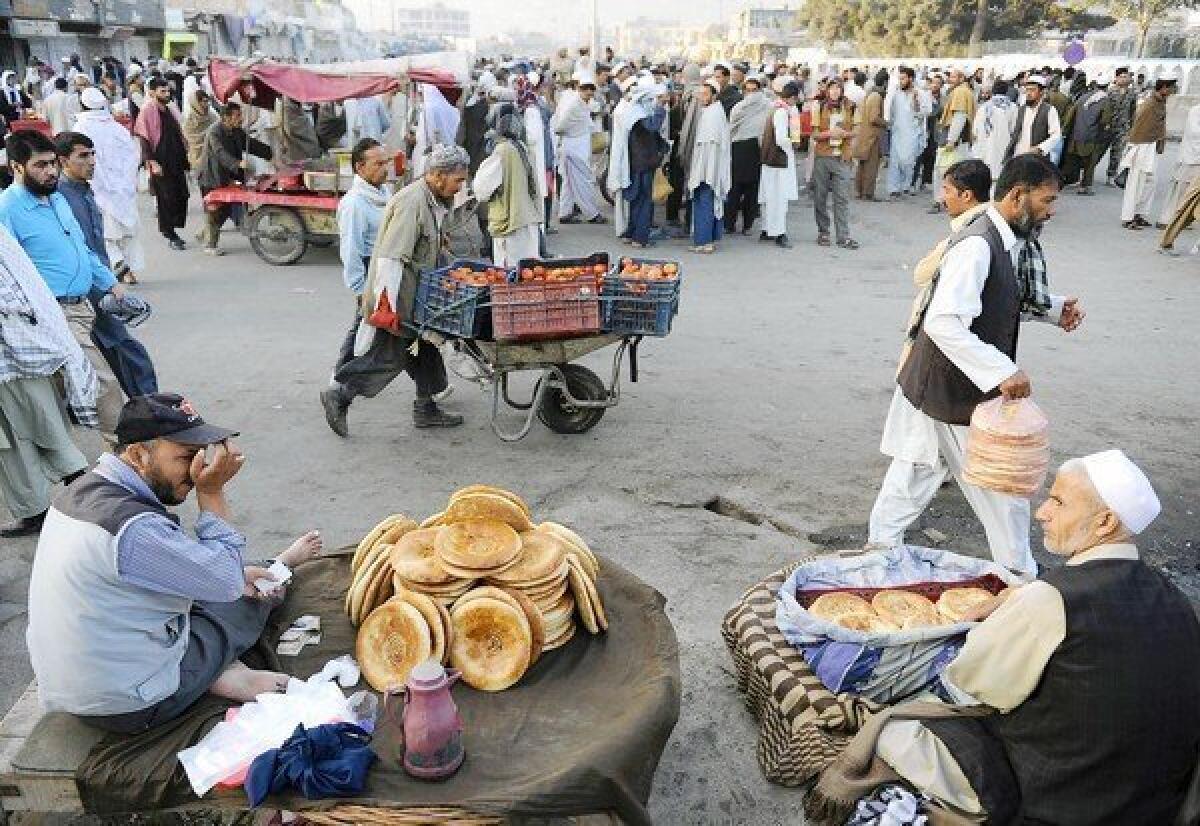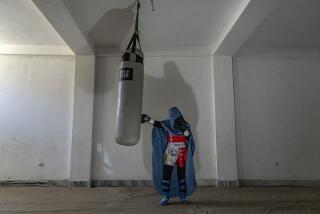Farewell to Afghanistan, with sadness and affection

- Share via
KABUL, Afghanistan — After years of comings and goings, almost everything about leaving Kabul is familiar: the ride through dusty dawn streets, skirting past old men on bicycles and boys in horse-drawn carts, the long airport trudge through four luggage screenings and pat-downs, the way the plane’s wingtips seem to almost scrape the jagged peaks surrounding the city.
Everything is the same — but the knowledge that this is the last time.
Kabul has been home for more than three years, but on this trip my assignment as a foreign correspondent here is ending, and I will join the American exodus from its long war in Afghanistan.
PHOTOS: A look back in Afghanistan
Most everyone here and at home shares the same perception: that Americans want to put this war in their rear-view mirror. But for many Afghans, too, there’s a bone-weariness with the foreign presence, outweighing even the fear of what will happen after most international forces leave.
At times, the sense of growing hostility is both palpable and personal: the neck-prickling sensation as you walk past an Afghan police post and feel the hostile gaze, or the female guard who turns a routine body search into a wholesale mauling, simply because she can.
But nearly every ugly experience is balanced by moments that make the heart lift: an elderly neighbor who beams as he presents a bunch of sweet-to-the-point-of-bursting grapes from the family farm outside Kabul, the schoolgirls in their white head scarves who shyly call out “How-are-YOU?” before dissolving into giggles.
And even in a city deformed by blast walls and barricades, with streets lined by open sewage ditches, beauty steals its way in. There’s the peacock strutting at dusk among the rosebushes, the warm smell of Afghan bread wafting from the corner bakery, an overnight dusting of snow in the ring of mountains.
Still, it’s clear just how messy the winding-down process is likely to be. Insider attacks — Afghan police and soldiers turning their guns on NATO troops — occur with clocklike regularity. Eruptions of anti-Western sentiment, triggered by events such as the burning of Korans by U.S. troops or the crude anti-Islam film that drew a violent response across the Muslim world, are beginning to have a depressingly familiar feel: Oh. Again.
From one day to the next, it’s easy to lose track of the war’s cumulative toll. Last week, scrolling through my cellphone directory, I realized how many of those listed in it had died violently: a mayor, two governors, a general, a women’s activist, a professor, a police chief, the president’s half-brother.
As a foreigner, I felt shielded from many of the dangers that ordinary Afghans face in their daily lives. The war’s violence killed or maimed more than 3,000 of them last year. The occasional close call was a reminder of that: Once, as I was riding in a car in downtown Kabul, a bomb went off about three blocks away. We felt the percussive thwump; the car shuddered hard once, like a dog shaking itself. I could see the driver’s hands trembling on the wheel as we, like everyone else, did a hard U-turn and drove off. Fast.
The American troop buildup came and went, and this was the year in which the U.S. dead in this war surpassed the 2,000 mark. Thousands more are maimed in ways that will mark them and our society for decades to come. When I was with troops in the field, I was always struck by how many of them cited the Sept. 11 attacks as their reason for enlisting. I’d ask them: How old were you then? And they’d say: Eleven, ma’am. Or maybe: Nine.
With the conflict’s end-days at hand, prognostication is a common Kabul pastime. Some predictions are dire: civil war, political collapse, the return of the Taliban to power. Others are more hopeful: that the country will find a way forward, if haltingly and painfully.
I’m not even trying to guess; if my time here has taught me anything, it’s what I don’t know about Afghanistan. This is a place where any presumption of understanding is routinely upended, sometimes humorously, sometimes brutally. It can be as gentle as a birdlike “chk-chk” sound when you are pressing some respected tribal elder too hard on a delicate question, or a warning, issued in a rapid harsh whisper, to leave some provincial town — right now, quickly and before dark — because your host cannot guarantee your safety.
Among so many unknowables, I do know this: It is mainly the faces of the Afghan women and girls that will stay with me.
There was the little girl, a ragged sprite I’d sometimes see when I went to the headquarters of the NATO force for an interview or a news conference. She was part of a gaggle of street kids who sold matches or trinkets to passing foreigners; I remembered her because she stood out from the boy gang, and because she was so small, with such a bright and curious smile.
It wasn’t until after the bombing that killed her and five of her friends last month that I learned her name: Parwana. Butterfly, in Dari. She was 8 years old.
There was Rahmaniya, an improbably stylish and articulate 18-year-old student from Kandahar who wanted nothing more than to keep learning. But her brother was threatening to kill her if she continued her studies. A sympathetic school principal was trying to help her find refuge in another city, but she could not bear the idea of leaving her mother and sisters. “I would kill myself if it weren’t a sin,” she said.
There was a woman named Humaira, whose face was so disarranged by repeated beatings from her husband that it resembled a Cubist painting. I met her in a women’s shelter in Kabul, where she was trying to learn a skill — needlework — so she could support herself. She smiled as she showed me her pinpricked fingertips, a badge of her dreams of independence. But a woman living on her own is almost unheard of, and eventually she went back to her abuser.
That’s not to say there aren’t success stories; in spite of the odds, many women here build remarkable lives for themselves and their families. Parliament member Fawzia Koofi, seen by many as a possible presidential contender, clawed her way out of a desperately impoverished childhood, the 19th of a family of 23 children. Repeated assassination attempts and death threats have failed to drive her from public life.
But most of the educated Afghans I know, men and women alike, are intently focused these days on contingency planning. The luckiest among them have foreign passports and foreign bank accounts, and in the last year, more acquaintances than ever before have approached me to plead for help in getting a U.S. visa.
Leaving, or trying to, is not a decision anyone takes lightly; love of homeland is a signature Afghan trait. This flight, though, spells a rapidly depleting pool of precisely the kind of people whose skills and talents are the most sorely needed at this perilous juncture.
I think every outsider who spends time in Afghanistan comes away changed. You witness things that frighten you, sadden you, infuriate you, surprise you — and you bear them all away like a skein of tangled thread, to be unknotted slowly, later. Back in the “normal” world, its ordinary comforts — home, family, physical safety — have the feel of something extraordinary. But mundane problems can also be oddly confounding, a puzzle you’ve forgotten how to solve.
It’s not my country, and it never was. But there was much about it I came to love. Over the last few weeks, as I told people — Westerners and Afghans — that I was leaving, I’d often get the same response: “Oh, you’ll miss Afghanistan!” It was usually meant sarcastically, as in, “Look at this place! Who’d miss it?”
But I will.
More to Read
Sign up for Essential California
The most important California stories and recommendations in your inbox every morning.
You may occasionally receive promotional content from the Los Angeles Times.










